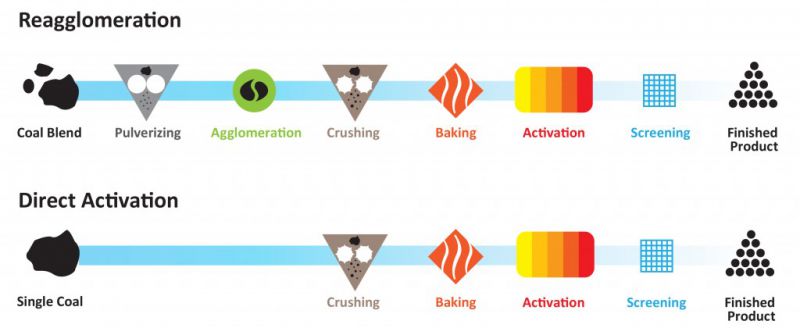Granular Activated Carbon as an Adsorption and Filtration Medium
Published on by Water Network Research, Official research team of The Water Network in Technology
Granular activated carbon (GAC) is a hybrid mixture of a wide variety of graphite platelets that are interconnected by nongraphitic carbon bonding. The adsorptive capacity of GAC makes it ideal for removing a variety of contaminants from water, air, liquids and gases
GAC is also an environmentally responsible product that can be reactivated through thermal oxidation and used multiple times for the same application.
The U.S. Environmental Protection Agency (EPA) and most state-based departments of health consider adsorption by GAC to be the best available technology for the removal of many organic materials in surface water. On its own or paired with an ultraviolet (UV) disinfection system, GAC can facilitate the removal of:
- Disinfection byproducts (DBPs) associated with chlorine and alternative disinfectants
- Algal toxins, such as microcystin-LR, cylindrospermopsin and anatoxin-A
- Endocrine-disrupting compounds
- Pharmaceuticals and personal care products
- Taste and odor-causing compounds
- Organic materials from decaying plants and other naturally occurring matter which serve as the precursors for DBPs
The following is a review of the fundamental aspects of activated carbon and specifically the use of GAC as a filter and adsorbent in potable water treatment.
Activated carbon production
Activated carbons are produced from a wide variety of carbon-rich precursor materials such as bituminous coal, anthracite, subbituminous coal, lignite, wood, coconut shells and peat.
These materials are converted into activated carbon by either thermal or chemical activation processes. Thermal treatment typically includes steam gasification (activation) and chemical activation uses reactive, inorganic additives at relatively lower temperatures.
Activated carbons produced from bituminous coal can be classified as direct activated or reagglomerated. Direct activation involves sizing the coal to approximately the final particle size required and thermally activating the sized coal. Direct activation can produce a less costly product compared to reagglomeration.
Reagglomeration involves first pulverizing and briquetting the coal with organic binders. The briquettes are stage crushed to achieve the desired particle size. Once the reagglomerated material has been activated, the binder is also converted to a graphitic structure that interconnects the activated coal particles. The hardness and abrasion characteristics of reagglomerated and direct activated GAC are often comparable. However, reagglomerated carbons tend to have a more homogenous pore structure that can be better for certain organic contaminant removal.
During thermal treatment, all the carbonaceous raw material reacts by means of condensation reactions to form increasingly larger aromatic plate structures. The density of the structure is influenced by the characteristics of the raw materials. The denser the raw material, such as bituminous coal, the more extensive the structures will be. These extended flat graphite platelets are arranged randomly within the GAC particle to provide the extensive internal structure needed for adsorption to occur.
Source: WT
Read More Related Content On This Topic - Click Here
Media
Taxonomy
- Filtration
- Technology
- Carbon